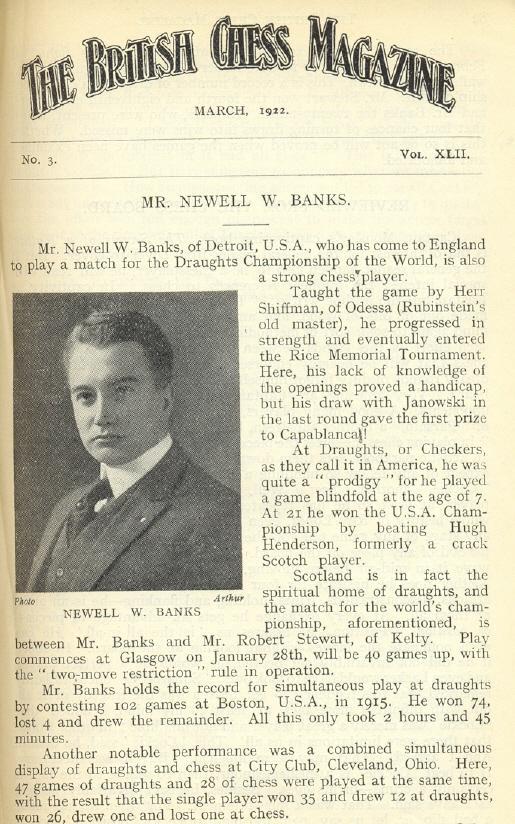
Edward Winter
Page 257 of the May 1977 Chess Life & Review accorded three lines to the death of Newell Banks, ‘one of the world’s leading checker players and a chess master’.
We shall be writing more about him, but for now a passage by Roy A. Alcorn is given from page 8 of Banks’ 1953 book World’s Championship Checker Match American Style:
‘Banks’ precociousness was not limited to checkers alone. At the tender age of eight he was introduced to the game of chess by his father and was, in a matter of months, winning games from the best chess brains in the city [Detroit]. Later, at the age of 22, he was the only man in the country [sic] to defeat in a crossboard game the great chess master José Capablanca, at Kansas City, Missouri, in 1909, who had just won the American Chess championship from Frank Marshall.’
More information about that game is sought. As regards simultaneous displays, in 1909 the Cuban gave two in Kansas City, on 4 February (four losses) and on 4 December (one loss), as listed in the American Chess Bulletin (March 1909, page 59 and February 1910, page 28). Was Banks the winner in the latter exhibition? In 1987 a local librarian informed us that he had found no mention of Capablanca’s visit in the Kansas City Times and Star of the time, but perhaps a reader could kindly look into the matter.
(4531)
A passage from pages 179-180 of the September-October 1915 American Chess Bulletin:
‘Among the leading chess experts Banks has encountered informally are J.R. Capablanca, E. Michelsen, E.P. Elliott, C. Jaffe, N.T. Whitaker, M. Schroeder, H.G. Daniels and H.L. Perrin. Some six years ago he played six games with Capablanca, of which he won one, losing the rest. Against the other strong opponents he made about an even score or better. Banks says that he owes most of his chess knowledge to Shiffman, of Odessa, Russia, the teacher of Rubinstein. This was about two years ago, when he gave Banks the odds of a rook. In six months he could only concede the odds of a pawn and move and, at the end of two years, he more than held his own against his teacher. Banks says that he owes much also to E. Michelsen, who instructed him in the openings when he first took up chess.’
Once again we express the hope that a reader suitably placed can look into Capablanca v Banks, Kansas City, 1909.
(4539)
Following on from the recent items about Newell W. Banks (C.N.s 4531 and 4539), our intention was to give one or two little-known victories by him, but it is proving surprisingly difficult to find suitable game-scores. Any suggestions from readers will therefore be appreciated. Another loose end is Banks’ second forename.
Meanwhile, attention is drawn to a feature about him on pages 81-82 of the March 1922 BCM:


The photograph below was published on page 76 of the March 1960 Chess Review:
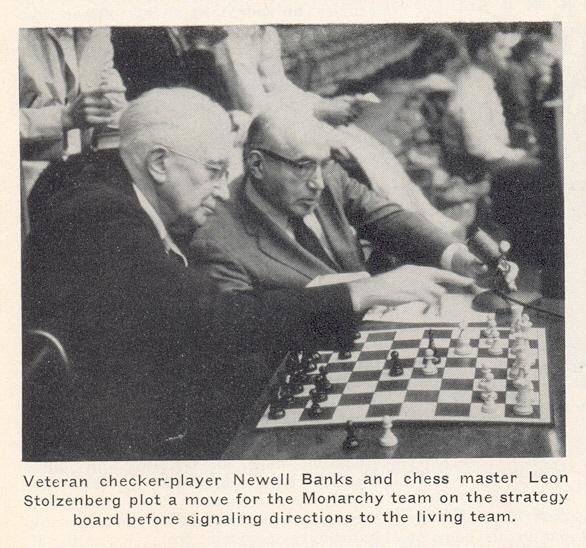
Accounts of Banks’ accomplishments at checkers are abundant, one example being the biographical note in his book World’s Championship Checker Match American Style, published in 1953. On pages 8-9 Roy A. Alcorn made a spectacular series of claims:
‘Banks played his first game of blindfold checkers at age five years and six months at the Detroit Chess and Checker Club.
Mr Banks has traveled over 1,000,000 miles in the past 45 years and played about 600,000 checkers and chess games. During this time he has played over 80,000 blindfold games, which is a number that probably exceeds more than that of [sic] any three blindfold players combined in the past.
At the present time, Mr Banks holds all speed records at blindfold and simultaneous checkers; namely 20 games blindfold at one time in 2 hours and 25 minutes at Bethlehem, PA in 1933, winning 17, drawing 3.
At the Century of Progress in Chicago, in 1933, Mr Banks played 140 games of checkers simultaneously in 145 minutes – winning 133, drawing 7, and making an average of about one move per second.
Newell W. Banks holds the world’s championship speed record at mixed play, having played 75 checkers and 25 chess games simultaneously, and at the same time six games of blindfold checkers in four hours’ time (240 minutes), winning 65 checkers games, drawing 10, winning 4 blindfold and drawing 2, winning 22 chess games, drawing 2 and losing only 1. This exhibition was held at the Tuller Hotel, Detroit, in 1932.
Mr Banks at age 60 set [an] endurance blindfold record that is one of the world’s wonders. He played four hours per day for 45 consecutive days, winning 1,331, drawing 54 and losing 2, playing 6 games at a time. He set a new blindfold speed record playing 62 games in four hours, winning 61 and 1 drawn at Convention Hall, Detroit, MI, during this endurance record.
It is important to remember that Newell W. Banks is the only living master at both chess and checkers and also one of the leading promoters of both games in America. He is also one of the few men in history who can play both chess and checkers blindfold.’
Our copy of Banks’ book, heavily annotated in pen, was previously owned by the checkers writer Tom Wiswell. A sample page is given below:
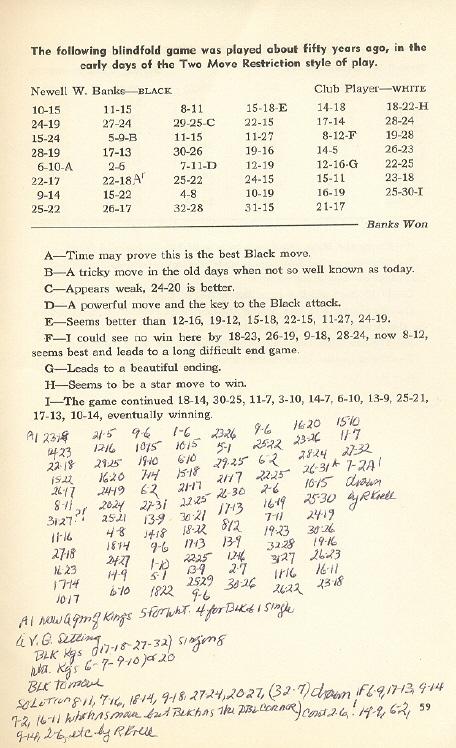
(4541)
Dan Scoones (Victoria, BC, Canada) notes that Newell Banks’ second forename was given as Williams in the book Banks’ Scientific Checkers (second edition, Detroit, 1929). Indeed, it appeared not only on the front cover and the title page but also in the caption to a fine portrait of him:
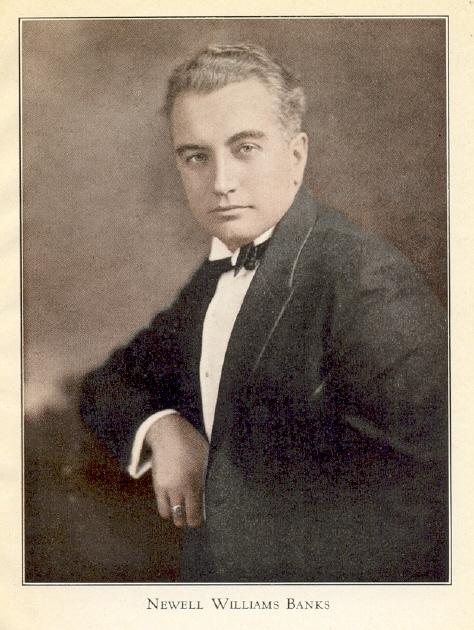
(4544)
Continuing the series of items on Newell Williams Banks (1887-1977), we add that C.N. 2431 (see page 98 of A Chess Omnibus) quoted his remark ‘Draughts is 80% memory, 20% intuition; chess precisely the reverse’. That came from an article by Banks entitled ‘Chess and its Sister Game’ on pages 314-315 of CHESS, 14 May 1939, and some further quotes are given below:
‘Chess is played with 32 pieces on 64 squares, draughts with 24 pieces on 32, so that obviously there must be many more possibilities in chess, and consequently more complications. Complications do not always mean science.
Chess is a game of the opening and middlegame; checkers of the ending. Four out of every five games of chess are decided in the first 30 or 40 moves; only occasionally does a player wrest a win out of an originally even endgame. On the other hand, middlegame combinations in draughts are rare, at any rate between good players, most games being decided only in the concluding stages.
A chess position is easier to size up. You can often find the weaknesses in one player’s game at a glance, he has a bad pawn position or an exposed king, or such like. At draughts a weakness may be most subtly concealed, only to be exploited by one single delicately-timed sequence of moves.
Draughts has been the more exhaustively explored, and it is in this connection that I think it must most definitely acknowledge the superiority of its rival. For instance, the “Single Corner” opening must have been played countless millions of times in the past 500 years, and is known inside out, to ten or 15 moves on each side.’
‘... Dr Alekhine’s knight sacrifice on the fifth [sic – sixth] move of a Queen’s Gambit in a world’s championship match, with a move that had never been explored before, is a phenomenon absolutely inconceivable in draughts.’
‘... Of the two games, which do I prefer? This is a question not to be answered lightly. Although as a draughts player I held the American championship for 25 years, whereas my best achievements at chess were probably my isolated victories over Marshall and Kashdan in one tournament, I have to admit that I get more enjoyment out of my chess. Mainly for its greater variety.’
For the score of Banks’ victory over Kashdan (at Chicago, 1926), see pages 78-79 of Wonders and Curiosities of Chess by I. Chernev (New York, 1974).
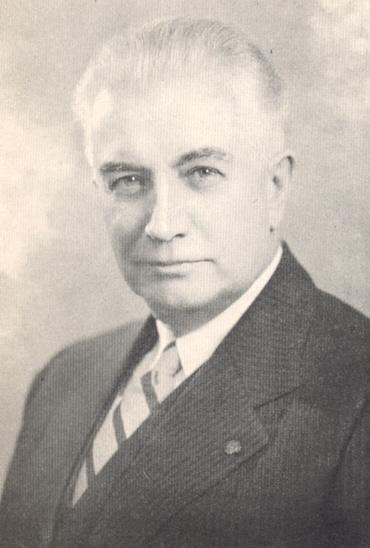
Newell Williams Banks
Banks also wrote a feature ‘Chess vs. Checkers’ on pages 13-18 of Banks’ Blindfold Checker Masterpieces (Philadelphia, 1947), from which the above photograph is taken. Some extracts follow.
‘In the course of 50 years of checkers and 45 years of chess, after a careful study of both games, I have reached the following conclusions. Checkers is a game of the endings or as it is often called a game of [scales] or balance, while chess is a game of time. In view of the fact that checkers is played with 12 pieces on a side, on 32 squares, while chess is played on 64 squares with 16 pieces a side, one does not have to be much of a mathematician to prove that chess has at least 100 times as many possible moves as checkers. This fact, however, does not detract from checkers since neither game has ever been mastered. However, if a master mind could completely unravel the mysteries of both games, checkers, undoubtedly, would be mastered first. The end play in checkers is more subtle than chess, for while the moves are more restricted, the timing is, nevertheless, more profound. ... The overwhelming beauty in chess lies in the opening and the middlegame, both of which fields, in my opinion, are unquestionably far superior to those in checkers.’
‘A beginner can learn to play a fairly competent amateur game of chess in one-third the time he can learn checkers. This does not mean that checkers is the more difficult game. What it means is that since checkers has been analyzed at least five times more thoroughly than chess, the beginner at checkers is called upon to absorb a formidable amount of book. It also means that checkers is a great game of memory, a point in its favor, from an educational point of view, since it is plausible to deduce that this practice would tend to stimulate the memory processes in other fields of endeavor.’
‘... As a youngster I learned more about chess looking over [Morphy’s] masterpieces, for about six months, than from any book I ever studied. I recommended the wholehearted study of Morphy’s game to the chess beginners. By all means let them delve into the Steinitz closed system of horizontal play, but, first, let the student be exposed to the principal [sic] of mobility, the beauty of dazzling sacrificial combinations and the open game.’
‘It may be wondered why I do not stress the merits of the endgame in chess. The reason for this is that 90% of all match games, as well as international tournaments, are decided in the opening and middlegame, and it is indeed a rare occasion when a game is won by superlative endgame play.’
‘It is my contention that chess is a great asset to a checker player’s opening and mid-game strategy, while checkers is of great value in improving a chessplayer’s sense of timing in the endgame. For these reasons alone, I advise serious students, of either game, to study both chess and checkers.’
‘An important point stressed by most checker players in favor of checkers is the fact that you must move forward at all times until the King Row is reached, the slightest mistake usually being fatal. In chess, on the other hand, if a minor error is made, you can retreat (except in the case of pawns) and in many cases by doing so avoid disaster.
Another point often made to stress the greater precision evolved in checkers is the fact that one piece down in any normal position will lose, while in chess even king and two knights will not win against a lone king.
However, in actual practice, the fact remains that compared with checkers very few chess encounters are drawn, due mainly to the tremendous scope of the middlegame, which has been aptly termed “The soul of chess” ...’
‘Finally, in answering the question, “which is the greater game – chess or checkers” – I must, in all frankness, favor chess. This statement, coming from the blindfold checker champion of the world may be received with real surprise by many checker players. However, I feel sure that any fair-minded person, reading this article, will understand the reasons that have led me to this conclusion.’
In an article by I.E. Porter page 6 of Banks’ Blindfold Checker Masterpieces referred to Capablanca (with various obvious inaccuracies):
‘When both Banks and the late José Capablanca were young and eager, back in 1909, Capablanca made his first US tour. He had just beaten the late Frank J. Marshall for the American championship, and starting from New York he travelled to the Pacific Coast and back, playing all-comers in exhibition matches. Of the hundreds of games played on this tour, the great Cuban, then not quite 21, lost just one crossboard game – to Newell W. Banks of Kansas City, MO.’
The book also contained (on pages 10-12) an article entitled ‘Recollections of a Veteran’ by H. Helms which referred to a mysterious figure already mentioned in C.N.s 4539 and 4541:
‘Banks learned the moves of chess at home from his father. At 14, he met a Russian refugee by the name of Schiffman. Before leaving Europe, Schiffman had given a helping hand to Rubinstein and Salve, then aspiring young players. He took an interest in little Banks, who from then on progressed rapidly.’
The coupling of Rubinstein and ‘Salve’ as aspiring young players is strange; Georg Salwe was 20 years older than Rubinstein.
Page 14 of our book on Capablanca presented a victory by the Cuban over a player named Schiffman in a simultaneous exhibition in Detroit on 21 January 1909, taken from the Detroit Free Press of the following day. The newspaper described Schiffman as ‘the local expert’. We wonder whether this was the same Schiffman, and not least because Detroit was Banks’ native city.
(4550)
C.N. 4550 quoted Banks’ remark, ‘my best achievements at chess were probably my isolated victories over Marshall and Kashdan in one tournament’. That was in Chicago, 1926, and the event was won by Marshall ahead of Maróczy and Torre. Strange to say, it has not yet proved possible to find the game-score of Banks’ win over Marshall.
On pages 11-12 of Banks’ Blindfold Checker Masterpieces by N.W. Banks (Philadelphia, 1947) H. Helms wrote:
‘Marshall, as a rule, was a good loser. I can vividly recall his chagrin at losing this game. For a brief spell he was completely upset. They were nearing the end of the contest and the United States champion felt that this point might cost him the prize.
However, Fortune favored Marshall in the final round, in which all the “breaks” were in his favor and he came through half a point in advance of the field. It was in that round that Banks won brilliantly against Kashdan.’
Below is an inscription by Banks in one of our copies of the second edition of Banks’ Scientific Checkers (Detroit, 1929):
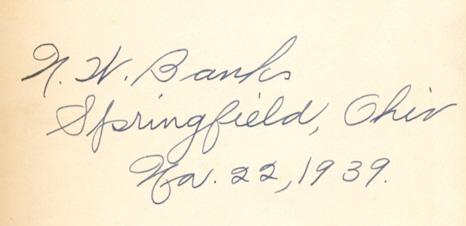
(4562)
C.N. 4562 quoted H. Helms’ remark that Frank J. Marshall was ‘completely upset’ after losing to Newell Banks at Chicago, 1926, and we mentioned our inability to find the game-score. Jack O’Keefe (Ann Arbor, MI, USA) has now traced it in Helms’ column on page 4A of the Brooklyn Daily Eagle, 16 September 1926. The introduction read:
‘In the ninth round [Banks] came near blighting Marshall’s prospects by defeating the United States professional chess champion. The latter took the ending entirely too easy, and the Detroiter demonstrated that it contained greater possibilities than what his redoubtable opponent had suspected.’
Newell Williams Banks – Frank James Marshall
Chicago, 1926
Queen’s Pawn Opening
1 d4 d5 2 Nf3 Nf6 3 Bg5 e6 4 e3 h6 5 Bf4 c5 6 c3 Nc6 7 Nbd2 Bd6 8 Bxd6 Qxd6 9 Bb5 O-O 10 O-O Bd7 11 Qe2 a6 12 Bxc6 Bxc6 13 Rfe1 Ne4 14 Ne5 Be8 15 f4 f6 16 Nxe4 dxe4 17 Nc4 Qc7 18 dxc5 Qxc5 19 Nd2 Qf5 20 g4 Qg6 21 Qg2 Rd8 22 Rad1 Rd3 23 Nb3 Ba4 24 Rxd3 exd3 25 Nc5 Bc6 26 e4 Rd8
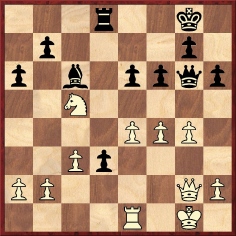
27 Rd1 f5 28 Rxd3 Rxd3 29 Nxd3 Bxe4 30 Ne5 Qf6 31 Qd2 fxg4 32 Nxg4 Qg6 33 h3 Bd5 34 Kf2 Qe4 35 Ne5 Qg2+ 36 Ke3 Qxh3+ 37 Kd4 Qh1 38 c4 Qg1+ 39 Qe3 Qxe3+ 40 Kxe3 Bc6
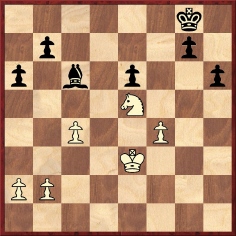
41 Kd4 h5 42 b4 h4 43 Kc5 h3 44 Ng4 Bf3 45 Nh2 Be2 46 a4 Kf7 47 b5 axb5 48 cxb5 Bd1 49 a5 Be2
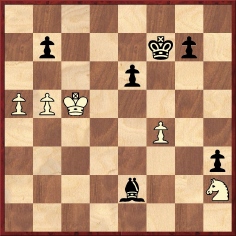
50 a6 b6+ 51 Kxb6 Bd3 52 a7 Be4 53 Kc7 e5 54 fxe5 Ke6 55 b6 Kxe5 56 b7 Bxb7 57 Kxb7 Kf4 58 a8(Q) Kg3 59 Qb8+ Kg2 60 Kc6 g5 61 Kd5 Kh1 62 Ke4 g4 63 Nxg4 Resigns.
(4583)
Arie van der Stoep (Hooge Zwaluwe, the Netherlands) sends the following from The Draughts Review, December 1927, page 231:
‘Mr Banks was playing ten games blindfolded. Among the players were Alfred Jordan (he was always glad to play) and Dr Lasker, the chess champion.’
Page 7 of Banks’ Blindfold Checker Masterpieces by Newell W. Banks (Philadelphia, 1947) quoted his view of F.J. Marshall:
‘I received more good ideas on opening and mid-game chess play from my old friend Frank Marshall than from all the other chessplayers I have known. If Marshall had had the urge to continue to apply himself to study and analysis he could have been at the top all his life. He was the greatest natural player of them all.’
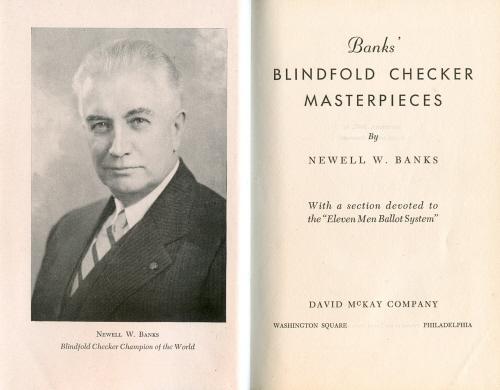
(6495)
This game was published on page 219 of the December 1924 American Chess Bulletin:
William Allen Ruth – Newell Williams Banks
Western Tournament, Detroit, 1924
English Opening
(Notes by Carlos Torre)
1 c4 Nf6 2 Nc3 e5 3 g3 d6 4 Bg2 Be7 5 e3 Nc6 6 d4 exd4 7 exd4 O-O 8 Nge2 Bf5 9 O-O Qd7 10 b3 Rae8 11 Nf4 Bd8 12 Bb2 g5 (‘Of course this is too bold. Black has reached a point where he cannot conceive any plan of action. The manner in which White takes advantage is highly artistic.’) 13 Nfd5 Bh3 14 Qf3 Bxg2 15 Nxf6+ Bxf6 16 Qxf6 Re6 17 Nd5 Bxf1 18 Qxg5+ Kh8 19 Nf6 Qd8
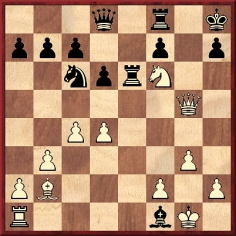
20 d5 Ne5 21 dxe6 Nf3+ (‘Of course if 21...fxe6 22 Kxf1 and f4.’) 22 Kxf1 Nxg5 23 e7 (‘But first 23 Nd5+ would have won without much difficulty.’) 23...Qxe7 24 Nd5+ Qe5 25 Bxe5+ dxe5 26 Nxc7 Nf3 27 Kg2 (‘27 Rd1 was very promising, for if 27... Nd4 then 28 Nb5.’) 27...Nd4 28 Re1 f6 29 Nd5 (‘29 f4, at once, was also possible.’) 29...Kg7 30 Re4 b5 31 f4 bxc4 32 fxe5 fxe5 33 bxc4 Nc6 34 Rg4+ Kf7 35 Rh4 Kg6 36 Rg4+ Kf7 37 Re4 Rb8 38 Re2 Rb1 39 Rf2+ Kg7 40 Kf3 Rc1 41 Ne3 Kf6 42 Ke4+ Ke6 43 Rf5 Ra1 44 Rh5 Kd6 45 Nd5 Kc5 (‘Not 45...Rxa2 at once, for then 46 Rh6+ and 47 Rxc6+. Black is making the most of it.’) 46 Rh6 (‘In the hope of catching Black, he again wastes valuable time. 46 Rxh7 at once and g4 should have been played.’) 46...a5 47 Ne3 Rxa2 48 Rxh7 a4 49 g4 a3 50 Rh8 Re2 51 Ra8 a2
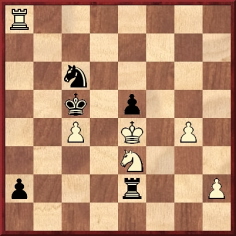
52 g5 Kb4 53 g6 Na5 54 g7 a1(Q) 55 g8(Q) Qd4+ 56 Kf5 Rxe3 57 Qb8+ Kxc4 (‘White has, of course, mismanaged the endgame sadly. Now Black good-naturedly takes the pawn. 57...Kc3 would probably have won. Let us say, 58 Rxa5 Rf3+ 59 Ke6 Qg4+, winning easily.’) 58 Qc7+ Drawn. (‘For if 58...Kd3 59 Rd8. Or 58...Kb3 59 Rb8+. A very interesting and instructive game.’)
(4986)
Two newspaper cuttings concerning Newell Williams Banks have been submitted by Russell Miller (Vancouver, WA, USA):
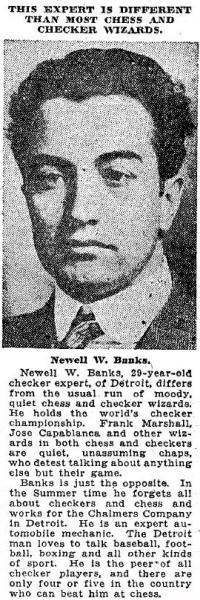
The Oregonian, 23 February 1917, page 19
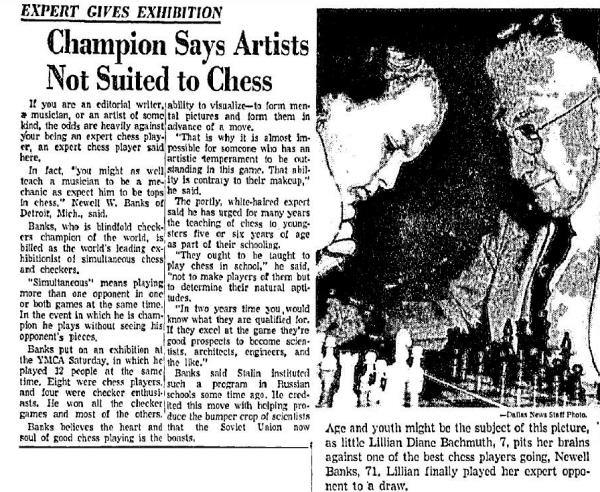
Dallas Morning News, 24 February 1958, part 2, page 6.
(6896)
A group photograph from the Western Chess Association tournament, Detroit, 1933:
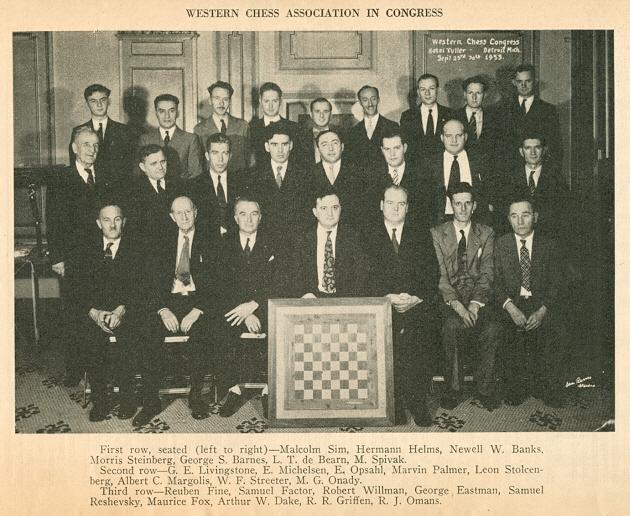
Source: American Chess Bulletin, September-October 1933, page 128.
(7257)

CHESS, 17 September 1935, page 15.
A group photograph (caption: ‘Newell W. Banks, the American chess-draughts-billiards wizard, in the centre of a crowd of people he played at Wisbech recently’) was published on page 294 of CHESS, 14 April 1939.
Another shot from around the same period:
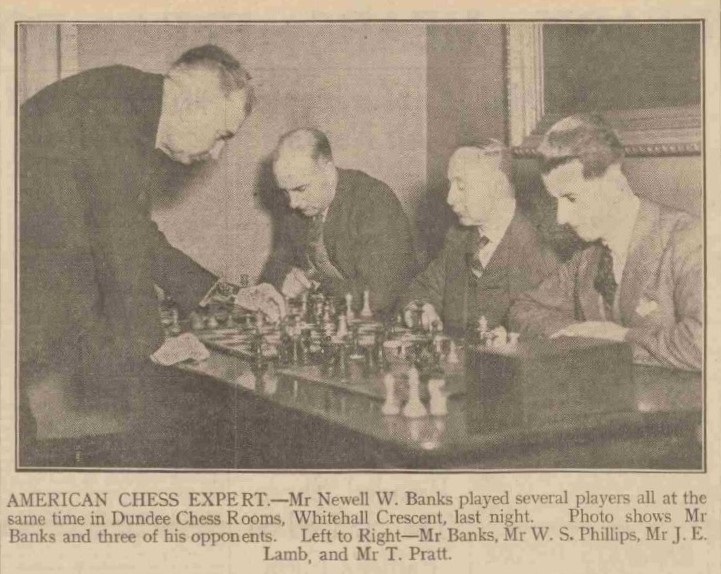
Dundee Evening Telegraph , 27 January 1939, page 8.
Patsy A. D’Eramo (North East, MD, USA) has found a cutting in the Chicago Daily Tribune, 21 February 1909, page 4, which refers to Capablanca and Banks and states:
‘In offhand games the brilliant young Cuban, however, won 11 games and lost only one – this to Newell Banks, the promising young expert at checkers who also plays an excellent game at chess.’
Our correspondent also notes reports about Capablanca in the Kansas City Times of 26 January 1909, page 5, and 6 February 1909, page 8.
(9139)
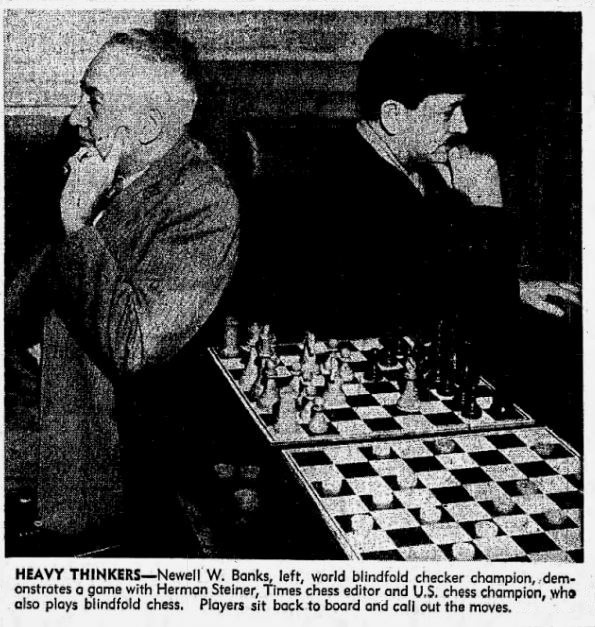
Source: Los Angeles Times, 29 December 1950, part 2, page 1.
(10209)
To the Chess Notes main page.
To the Archives for other feature articles.
Copyright: Edward Winter. All rights reserved.